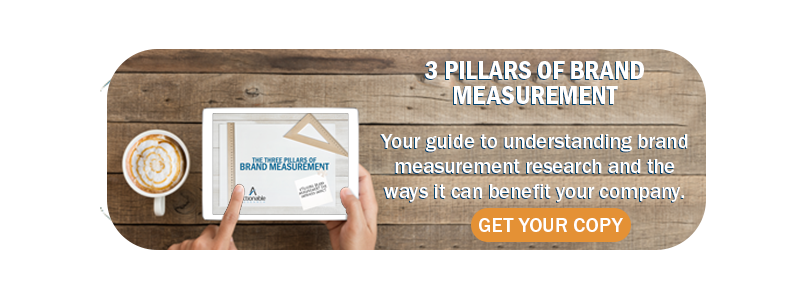A Component of Broader Research Goals
Over the past several weeks, we’ve covered many aspects of brand research, from the pillars that support brand research to the potential benefits of conducting a brand study. Now, we turn our focus to brand research in action. We’re giving you an inside peek at a few of the methods we’ve used to focus on brand measurement in the past.
If you take anything away from this blog, take this message with you:
Brand measurement research does not have to be conducted in a standalone survey.
At Actionable Research, it’s rare we create a survey that falls into one individual category. We build surveys with our clients, focusing on gathering information to help them solve a specific problem and meet their specific needs, and along the way we often have the opportunity to address specific goals and test additional components as well. Why not gather some key brand measurements while you’re already conducting customer satisfaction research? You’re already offering an incentive to respondents – why not get everything relevant and important from them that you can during this trip to the field? Here’s an example of a time when we did just that.
The Problem
Our client was a well-known player in the world of medical imaging. Known for being innovators, carrying one of the most-efficient and fastest solutions for diagnostics on the market, they provided a specific software platform for third-party devices. While their software worked extremely well and their name connection was strong, there was a concern that the hardware component of their offering was unable to meet the demands of their software, and that it was hurting their brand.
The client came to Actionable hoping to discover what attributes of their product could potentially be improved to prevent further damage to their brand image.
The Consultative Solution
Actionable team members met with the client and discussed their problem in-depth, looking for clarification and insight into their issues. We then built a survey to help answer these questions. Because the customer satisfaction concern bled into a concern with brand image, the survey was ultimately designed as a combination of both customer satisfaction and brand measurement.
The survey polled both customers of our client and users of other similar solutions. It asked them about their opinion on the different brands, and the specific products each offered – their impressions of the products, whether they would repurchase, and how the products could be improved.
Actionable Results
Results from the survey not only gave our client specific attributes they could potentially improve, but also gave them insights into the customers’ decision making process – which brands and which products they would buy, and why. The client additionally received indicators about how well, or poorly, competitors were performing and what was impacting their performance. The combination of current product performance and its impact on brand perception allowed the client to understand how big an issue their hardware concerns were, and offered insight into the best prescription for action.
Actionable Research provided the client with key takeaways they could use in making product design and positioning decisions, as well as Actionable recommendations for specific actions they could take to leverage their brand for maximum value.
Learn More
To learn more about brand research and the ways we conduct it, subscribe to our blog and get updated when we release the next two case studies.



